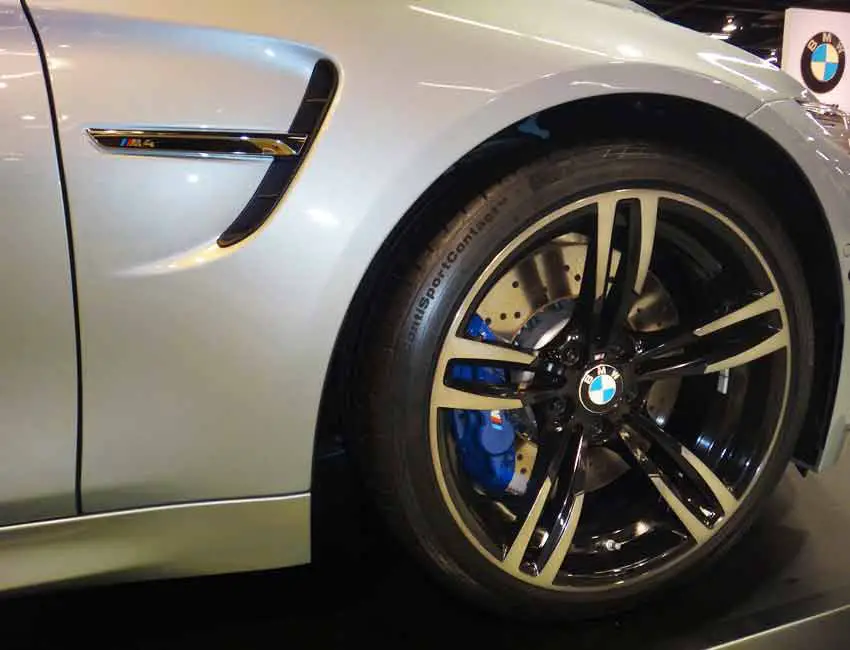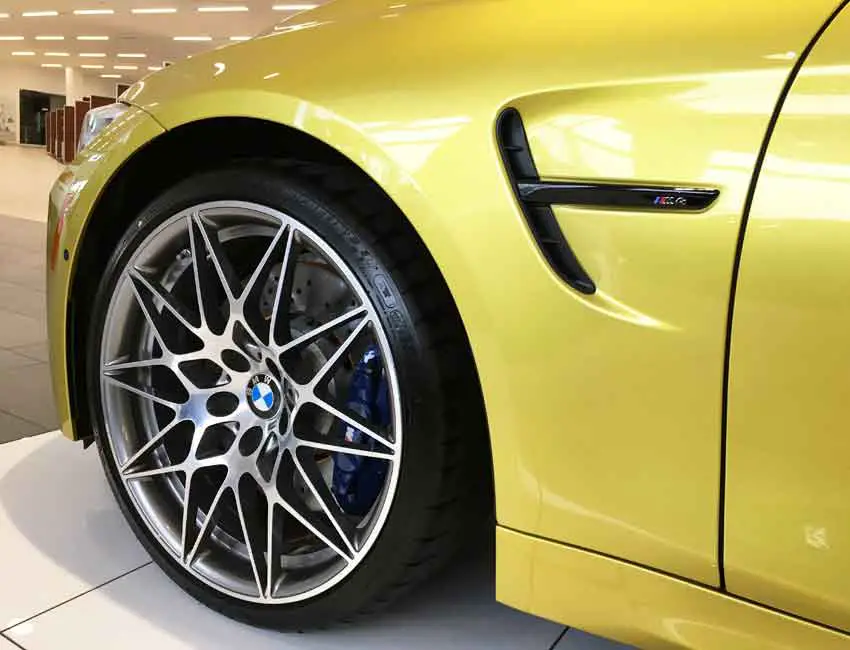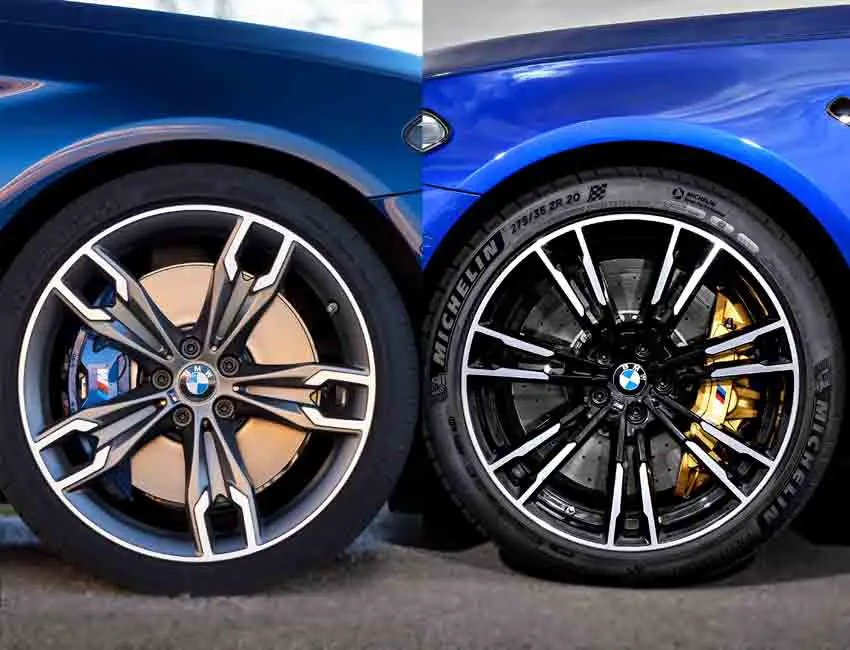The latest M Compound Brakes have a significant performance increase compared to the last generation. These brakes come as standard equipment on the BMW M models.
The New Generation of BMW M Compound Brakes
The M Compound Brakes have fixed-caliper brakes fitted onto both the front and rear axles. The front axle holds four pistons while the rear axle has two pistons. The setup is a significant performance increase compared to the predecessor where the axles had heavy single-piston sliding calipers.
According to Klaus Dullinger, the BMW M Engineer responsible for the development of the new standard BMW M Compound Brake system:
“M compound brakes have a grey-cast friction ring in a floating arrangement that is connected by pins to the aluminum brake cover. The pin assembly means that as the temperature increases, it can expand freely in a radial direction and subsequently cool down again without any residual deformation.”
BMW M Compound Brakes in a Glance
- M Performance Sport Brake Pad
- M Compound Brakes Running-In Period
- Bedding of the M Compound Brakes
- Crack Patterns Across the M Compound Brake Discs
- Wet M Compound Brakes
- Why is the Cool-Down Lap Important for the M Compound Brakes?
- Cleaning and Care of the M Compound Brakes
M Performance Sport Brake Pad
Along the new BMW M Compound Brakes, a new racing brake pad is developed — the M Performance Sport Brake Pad.
The new M Performance Sport Brake Pads have a much longer life expectancy compared to the conventional brake pads. These brake pads can withstand the high temperatures that result from the racetrack and have significantly more stable friction coefficient value.
M Compound Brakes Running-In Period
On the first full tank of gas, it is advised that drivers should restrain from using the maximum deceleration on the brakes and avoid hard emergency braking to allow the M Compound Brakes a “running-in” period. This is when the brake pads get accustomed to the brake discs.
Bedding of the M Compound Brakes
Within the first 500 km (about 310 miles) drive of a new BMW with M Compound Brakes, there is a process called bedding of the brakes which links to the friction ring. These two surfaces must become attuned to one another, as the 20 µm (micrometer) thick crosshatch of the new brake disc needs to wear away. Once gone, the bedding process of the new brake pad on the new disc can begin.
Crack Patterns Across the M Compound Brake Discs
At times, the surface of the M Compound Brake discs can show crack pattern formation. This happens when the disc is exposed to cold weather or is subjected to a heavy load.
For example, if you were driving on a race track and suddenly performed an emergency brake, the brake discs can become very hot in a short amount of time. The temperature can go from 20 degrees to 450 degrees in a few seconds. This is how the surface cracks begin to form. Fortunately, the cracks will only show on the surface area of the Brake discs.
Wet M Compound Brakes
When driving in the rain, during wet road conditions, or right after a car wash, the M Compound Brake discs and pads will experience a drop in their friction coefficient value. The braking effect may be equivalent to that of a conventional brake system when impacted by moisture and road salt.
This can be compensated by applying more pressure on the brakes until the pads and discs have dried out completely. At times, wet M Compound Brakes can cause an audible operational noise when the car brakes towards a stop. However, this does not affect the brakes’ performance, operational safety or stability.
Why is the Cool-Down Lap Important for the M Compound Brakes?
After driving with high speed or on the racetrack, it is essential for the M Compound Brakes to cool down with the airstream. If your BMW is parked while the brake discs are close to 500 degrees, heat can transfer throughout the brake system and damage brake pads, back plate, damping plates, brake calipers, piston seals, and the dust shields.
By performing a cool-down lap, the airstream can bring the temperature of the M Compound Brake discs down below 200 degrees.
Cleaning and Care of the M Compound Brakes
When taking your BMW with M Compound Brakes to a car wash, it is important to clean both brake discs and calipers with a steam jet or high-pressure cleaner. This prevents the formation of encrustations or deposits of salt crystals when the car is parked after cleaning.
If wheel cleaner is used, make sure it is only applied to the wheel rims and does not touch the brake discs or the calipers.
Use a wheel cleaner that is acid-free and pH balanced, which is safe on the BMW standard alloy and aluminum rims. If you have custom wheels with powder/decorative coating or any other special materials, be sure to check if the solution is safe for the material. Use a brush with extra-soft and scratch-free bristles to detail the rims if safe and necessary but avoid the brakes. Dry the wheels with a soft, lint-free, and non-scratch microfiber cloth that does not harm the wheel surface. You can go one step further by cleaning the tires separately with a non-toxic, environmentally-friendly tire dressing care and microfiber cleaning pad.
M Compound Brakes Versus M Carbon Ceramic Brakes
The BMW M Compound brakes are different from the M Carbon Ceramic brakes in terms of weight, performance, and price.
Here’s everything you need to know about the new generation BMW M Carbon Ceramic Brakes.

